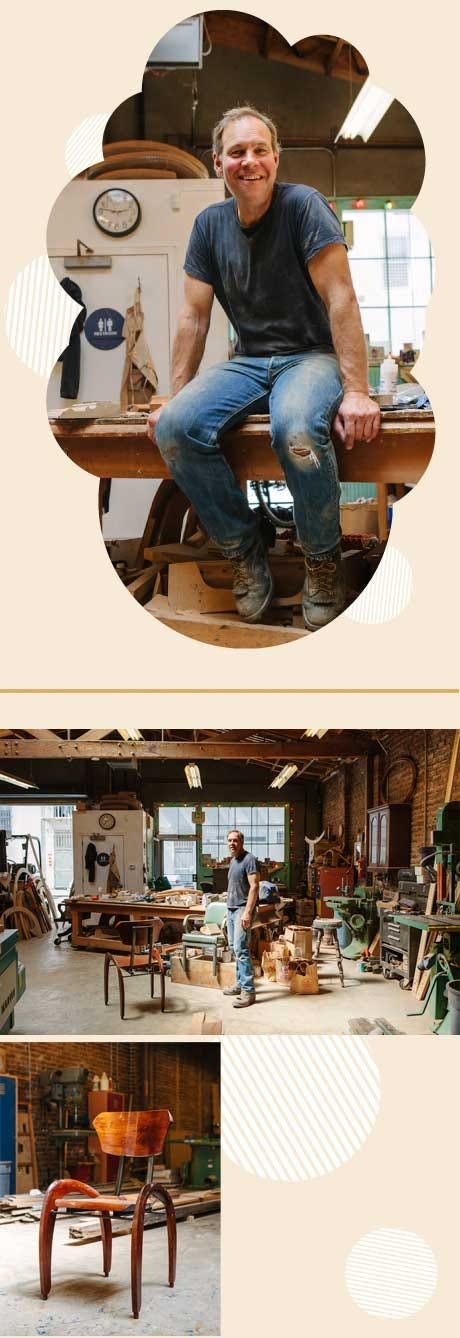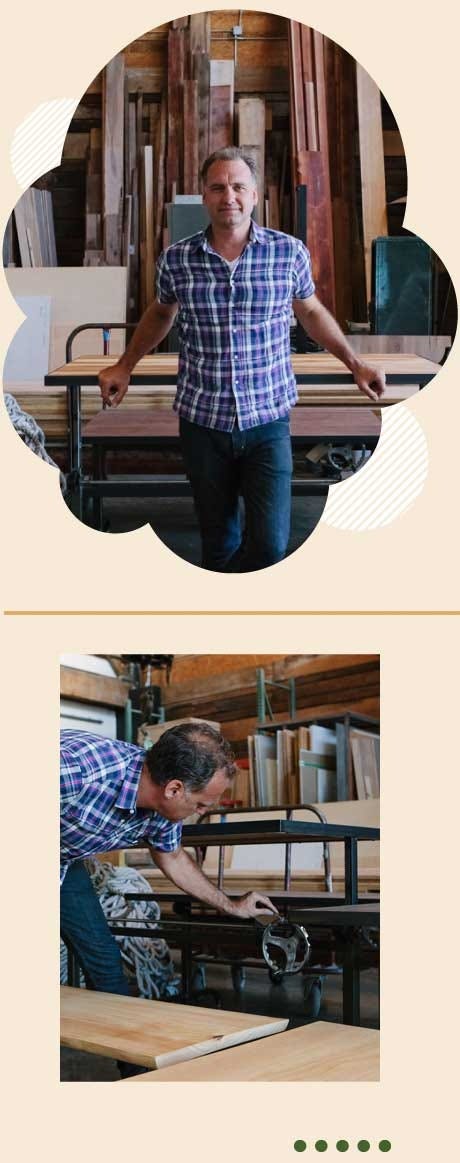
My dad was all about building stuff when I was growing up. His “projects,” as we affectionately called them, usually involved lumber and power tools. When I was older, I worked in my uncle’s furniture store in Berkeley, where I spent summers refinishing oak tables and chairs. Though I can still feel the burns from the paint stripper, having two of the men I most looked up to harbor such a passion for woodworking cemented a love in me as well.



I don’t get to work with lumber and power tools much anymore. San Francisco has great groups like TechShop and Woodshop that let you get your craftsman on, but for the most part it’s tough to find the space or time to build, say, new end tables. Yet some very brave people have made it part, if not all, of their livelihood.
In San Francisco, the design de jour may move through different metals and plastics, but in my mind wood will always be the foundation of good craftsmanship. I got in contact with a handful of local woodworkers and asked them about their projects — allowing me to live vicariously through them, if only for an instant.



What inspired you to get into woodworking?
My father and grandfather are both amazing carpenters. As a little kid I remember chasing them around in the woodshop, ending up with my overalls, my hair — in fact, all three and a half feet of me — being covered in sawdust.
What are the biggest challenges a woodworker faces working and selling in San Francisco?
Space versus cost. Narrow hallways are also a challenge.
Of all the pieces you’ve built, what’s your favorite?
An adjustable Stump Stool made out of a piece of olive wood that came from a friend’s farm in my hometown. My business partner, Will Pro, and I stripped all the bark off using drawknives and hand tools. Then we used a router for the inside so that the hardware could be inset, and sanded it to the perfect smoothness. The stool looks like one continual stump, until you sit on it and discover that it can be raised or lowered.
What’s the most complicated piece you’ve built?
A three-sided fireplace. It had three separate hearths and over 1,000 strips of ripped slats. This particular piece also had an insane time constraint: start to finish, one week. It was the type of project that physically and mentally exhausted me.
What is your favorite type of wood to work with?
Olive. It is an extremely hard wood that has amazing grain.


What inspired you to get into woodworking?
I grew up helping my father build things around the house and at our family business. People complimented the tables I had built for me and my wife, Parisa, and I enjoyed making them, so when the architecture industry dumped, I thought it would be a great way to spend the down time.
How does the city of San Francisco influence your style?
My aesthetic has softened up since moving to SF 10 years ago, but I think it probably needed it. Often architects are taught to be so stringent with their design that they overintellectualize every aspect until there is no soft character to connect with.
Of all the pieces you’ve built, what’s your favorite?
The table I am currently working on, an 11-foot-long by 4-foot-wide conference table made of a book-matched set of solid claro walnut slabs.
What’s the most complicated piece you’ve built?
This console table of reclaimed Douglas fir beams for my Hollow original concept line. As I started working, I realized that the faces with the original weathering were pretty severely concave. In the end I had to shape the joint by hand, check it against the adjacent piece, then continue to slowly shave it down.
What is your dream piece to build?
A friend of mine asked if I’d take a raw piece of a tree (that has an unimaginably deep, significant meaning to her and her family) and make something for her to keep with her for the rest of her life. It’s an intimidating order, but I cannot wait to get started.




What inspired you to get into woodworking?
My father owned a cabinet shop, and I started working there at age 10 during the summer. When I graduated with a fine arts degree in painting, falling back on my woodworking experience was a natural way to make a living.
What have your major influences been throughout your career?
Nineteenth- and twentieth-century painting, from Manet to Abstract Expressionism, and jazz. Recently, I’ve become familiar with the studio furniture movement that started in the ’30s with Wharton Esherick. I’m also very interested in exploring classic Chinese styles and techniques.
What are the biggest challenges a woodworker faces working and selling in San Francisco?
The biggest challenge for me is making ends meet. It’s very expensive to set up and maintain a well-equipped shop. I feel fortunate to have gotten this far, but it’s still a constant struggle to keep the doors open.
Of all the pieces you’ve built, what’s your favorite?
A Cubist-style end table I made that played on positive and negative space. I also enjoyed making a batch of sculptural solid cherry dining chairs that utilized a light steel sub-frame.
What’s the most complicated piece you’ve built and where is it now?
A 14-foot-long solid mahogany built-in cubbyhole bookshelf. It’s all dovetail, profiled, lots of profiled radius work and reeding. I own it because I don’t think anyone else could, or would pay for all the solid material and labor.
What is your favorite type of wood to work with?
Genuine mahogany because it’s very stable and mostly uniform in color and density.


Jared Rusten
What inspired you to get into woodworking?
Impatience. I’d always made things from scrap wood growing up: a wooden go-kart, skateboard ramps, loft beds, speaker cabinets, etcetera. I didn’t consider making furniture design or woodworking a profession, though, until I started a design degree program, taking general classes, working a desk job, and getting impatient to realize the designs I had floating around in my head.
What have your major influences been throughout your career?
My woodworking holy trinity is Sam Maloof, George Nakashima, and James Krenov.
How would you describe your woodworking style?
It’s something like a hand-wrought modernism. In many of my recent designs, I’m striving for a subtle and elusive thing that Apple has been pulling off for years: deceptively complex. The intelligence is hidden. The aesthetics are reduced to the cleanest and simplest form.
What’s the most complicated piece you’ve built and where is it now?
A very skeletal, bent-laminated lounge chair I called the Los Altos. The process of building it has so many steps, and requires so much attention, I haven’t featured it on my website recently for fear of being asked to build another one.
What is your dream piece to build?
I love building chairs. I go to sleep dreaming about chair designs.




What inspired you to get into woodworking?
I really got into metalworking first and then woodworking came in support of that. I found the “natural” with the man-made to be most interesting.
What have your major influences been throughout your career?
Donald Judd and Dieter Rams. I also have been inspired by traditional Japanese design. Everything is so completely controlled, but you would never know it as it looks and feels so natural.
How would you describe your woodworking style?
Very simple. Nothing more than it needs to be and “wood where you touch.”
How does the city of San Francisco influence that style?
The tech world is centered here and designing and building offices and furniture for them is really fantastic. They understand the importance of good design for environments and quality furniture. People need to feel good when they go to work.
What’s the most complicated piece you’ve built?
Our Adler table is the most complicated piece that we have built. I think right now it is the only good-looking mechanically adjustable table in the country. The next step is to make it electric or pneumatic.







